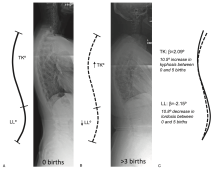Adult spinal deformity is a prevalent condition that often requires costly surgical management. Females are disproportionately represented in spinal deformity surgical cases with up to 90% of patients being women. The potential contributions of pregnancy on postural degeneration have only begun to be acknowledged and require further study.
Two hundred eight women with standing lateral radiographs were selected from the TwinsUK register. Parity information was extracted from questionnaires. Sagittal balance measurements (thoracic kyphosis, lumbar lordosis [LL], pelvic incidence [PI]) were collected and PI-LL mismatch was calculated. One-way analysis of variance tests were done between three separate age categories for measures of sagittal balance and parity and stepwise multivariate regression was done for PI-LL.
Both age and PI-LL mismatch significantly differed between parity categories. PI-LL was on average 7.0° ± 2.5° greater in multiparous (3+ births) subjects than in nulliparous subjects (P < 0.01). Parity did not have an independent relationship with lumbar disc degeneration, lumbar bone mineral density, or any of the individual sagittal balance parameters (P > 0.05 for all), except for PI-LL. From a subanalysis of the effect of parity on sagittal alignment within twin pairs, we found that within pair differences in parity associate with within pair differences in thoracic kyphosis.
This study established correlations between measures of spinal curvature in older women and parity for the first time. Longitudinal research is required to establish a causative relationship.
The effect of parity on age-related degenerative changes in sagittal balance
Bailey JF, Sparrey CJ, Williams FMK, Curran PF, Lotz JC, Kramer PA (2020) The effect of parity on age-related degenerative changes in sagittal balance. Spine 45:E210-216. Doi: 10.1097/BRS.0000000000003234
View PDF
(982.63 KB)
